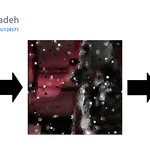Decay
I just finished my final project for the Coursera course ‘Introduction to computational arts’. The piece is called ‘Decay’ and it’s more a conceptual than a refined piece of work. It was done on a development platform called Processing.
I like the concepts of decay and glitch-art and have for a long time been fascinated with the trappings of post-apocalyptic themes. Also, the aspect of the Processing environment that really appeals to me is that it can run essentially forever and has the ability to introduce random elements.
The above ideas, I combined into a piece where an image is continuously parsed, with blocks of the image being replaced by the average color of the pixels in that block or, with small possibilities, by a black or white block. Then, based on the average color of each block, as well as the duration of the current audio file being played, a particular new audio file is played, typically somewhat overlapping the currently playing audio file or files.
The result is a randomly generated piece of work, which slowly degrades to uniformity, both visually and auditorily, as, slowly, the image should degrade to a uniform grey, while the audio should revert to one file playing over and over again.
In a way, this piece then represents digital decay.
There is no user interaction with the work. Only consumption. This emphasizes that the user is an observer, with no ability to stop the decay, integral to the work.
The work’s decay is based on a range of parameters which can be tweaked to make it work with images of variable size and various available durations of allowed decay.
The work is available online at OpenProcessing. Note, I only got this java applet to work, online, on Firefox. There’s currently a (less polished) javascript version available here. The latter should work on more platforms, but for the javascript version, performance appears to be much more an issue, due to the constant iterative nature of the piece.
The individual images used are cc-a images available from Flickr. Artists are credited inside the work.
The audio is from an audio pack available through freesound from user Erokia.

